Temperature-Dependent Superplasticity and Strengthening in CoNiCrFeMn High Entropy Alloy Nanowires Using Atomistic Simulations
Abstract
:1. Introduction
2. Simulation Details
2.1. Interatomic Potential
2.2. Nanowire Simulation Details
3. Results and Discussion
3.1. Deformation Behavior of Ag NWs and CoNiCrFeMn HEA NWs
3.2. Strengthening Mechanism of CoNiCrFeMn HEA NWs
3.3. Superplasticity in Ag NWs and CoNiCrFeMn HEA NWs
3.4. Role of Stacking Fault Energy in the Deformation Mechanism
4. Conclusions
- 1
- It is found that both Ag NWs and HEA NWs show unique superplastic behavior during tensile deformation at 77 K. In HEA NWs, dominant deformation mechanism is TWIP, aided by limited FCC-HCP martensitic transformation during the structural re-orientation, while Ag NW deforms via twinning induced surface re-orientation.
- 2
- At 300 K, during tensile deformation, the motion of partial dislocations is hindered by stacking fault networks resulting in formation of dislocation junctions or Lomer Cottrell locks in HEA nanowire. We speculate that variations in the local chemical composition in HEA nanowires facilitate the formation of Lomer Cottrell locks, which further promotes formation of nucleation sites for the HCP phase transformation. At a later stage of deformation, FCC-HCP martensitic transformation causes unlocking or annihilation of Lomer Cottrell locks. In contrast to deformation at 77 K, martensitic transformation induced plasticity overtakes the twinning induced plasticity in HEA nanowire, while Ag nanowire deforms mainly by dislocation slip with a little contribution from twinning.
- 3
- At 1000 K, FCC-HCP martensitic transformation dominates in HEA NWs, which results in the TRIP effect enabling additional ductility and refractory properties. Similar to 300 K, dislocation junctions or Lomer Cottrell locks are unlocked and annihilated at a later stage of deformation. On the other hand, Ag nanowires fail by dislocation slip.
- 4
- Increasing the deformation temperature of HEA nanowires leads to a decrease in the dislocation density, which is also responsible for shifting the deformation mechanism from TWIP to TRIP at elevated temperatures. With increasing temperature, martensitic transformation dominates as an independent mechanism and results in the annihilation or removal of Lomer Cottrell locks at the later stages of deformation. Thus, the synergistic sequence of plastic deformation mechanisms in HEA NWs at different stages of strain are the source of its excellent combination of strength, ductility, and toughness or damage tolerance which are in better agreement with the existing experimental and simulation studies.
Supplementary Materials
Author Contributions
Funding
Institutional Review Board Statement
Informed Consent Statement
Data Availability Statement
Acknowledgments
Conflicts of Interest
Abbreviations
| LC | Lomer Cottrell locks |
| NW | Nanowire |
| HEA | High entropy alloy |
| TWIP | Twinning induced plasticity |
| TRIP | Transformation induced plasticity |
Appendix A. DFT Simulation Details for the SFE Calculation
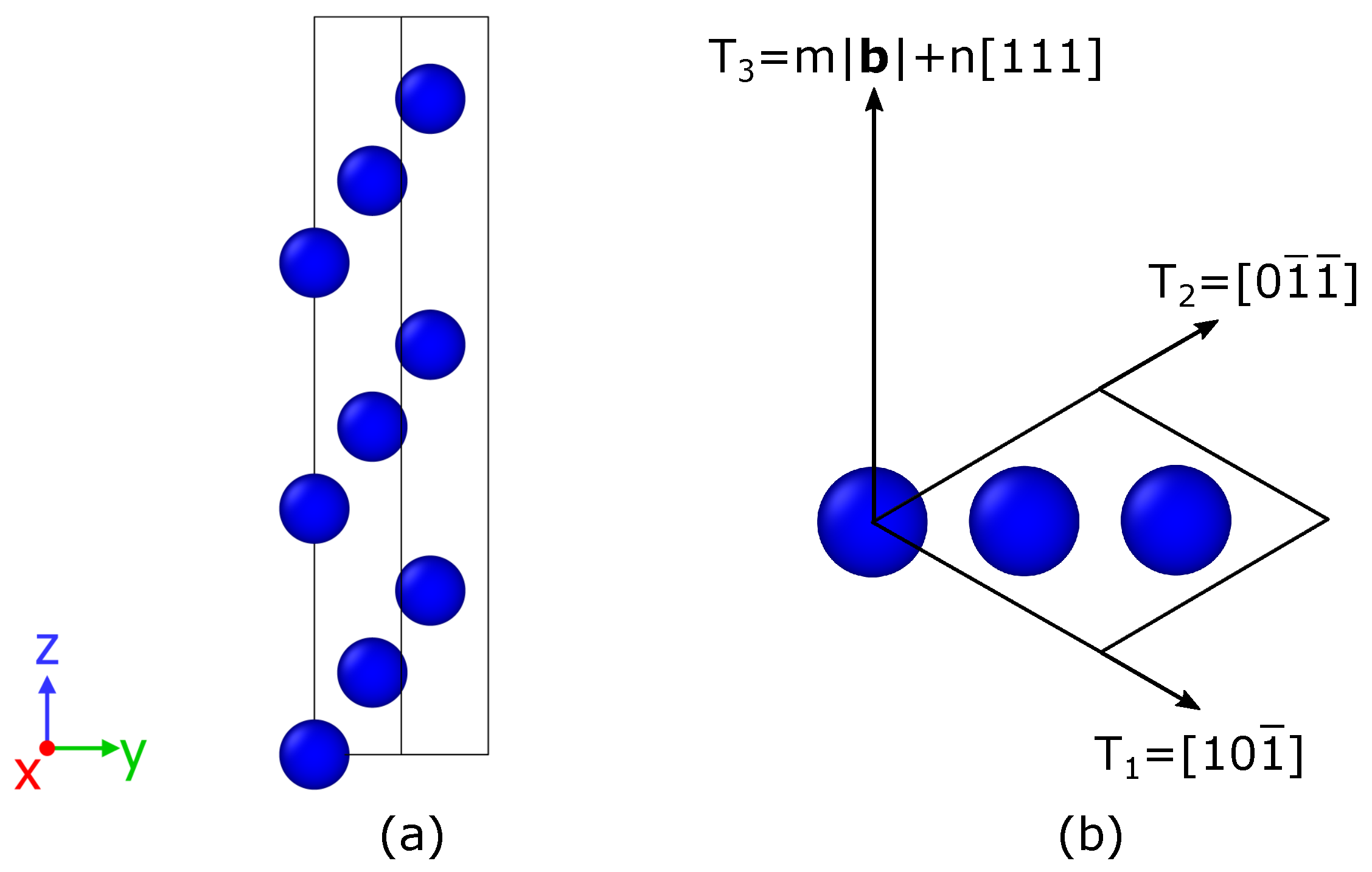

References
- Brenner, S.S. Tensile Strength of Whiskers. J. Appl. Phys. 1956, 27, 1484–1491. [Google Scholar] [CrossRef]
- Lieber, C.M.; Wang, Z.L. Functional Nanowires. MRS Bull. 2007, 32, 99–108. [Google Scholar] [CrossRef] [Green Version]
- Xia, Y.; Yang, P.; Sun, Y.; Wu, Y.; Mayers, B.; Gates, B.; Yin, Y.; Kim, F.; Yan, H. One-Dimensional Nanostructures: Synthesis, Characterization, and Applications. Adv. Mater. 2003, 15, 353–389. [Google Scholar] [CrossRef]
- Oh, J.S.; Oh, J.S.; Yeom, G.Y. Invisible Silver Nanomesh Skin Electrode via Mechanical Press Welding. Nanomaterials 2020, 10, 633. [Google Scholar] [CrossRef] [PubMed] [Green Version]
- Park, H.S.; Gall, K.; Zimmerman, J.A. Shape Memory and Pseudoelasticity in Metal Nanowires. Phys. Rev. Lett. 2005, 95, 255504. [Google Scholar] [CrossRef] [Green Version]
- Liang, W.; Zhou, M.; Ke, F. Shape Memory Effect in Cu Nanowires. Nano Lett. 2005, 5, 2039–2043. [Google Scholar] [CrossRef] [PubMed]
- Liang, W.; Zhou, M. Atomistic simulations reveal shape memory of fcc metal nanowires. Phys. Rev. B 2006, 73, 115409. [Google Scholar] [CrossRef] [Green Version]
- Rezaei, R.; Deng, C. Pseudoelasticity and shape memory effects in cylindrical FCC metal nanowires. Acta Mater. 2017, 132, 49–56. [Google Scholar] [CrossRef]
- Park, H.S.; Ji, C. On the thermomechanical deformation of silver shape memory nanowires. Acta Mater. 2006, 54, 2645–2654. [Google Scholar] [CrossRef]
- Cao, A.; Wei, Y. Atomistic simulations of the mechanical behavior of fivefold twinned nanowires. Phys. Rev. B 2006, 74, 214108. [Google Scholar] [CrossRef] [Green Version]
- Cao, A.J.; Wei, Y.G.; Mao, S.X. Deformation mechanisms of face-centered-cubic metal nanowires with twin boundaries. Appl. Phys. Lett. 2007, 90, 151909. [Google Scholar] [CrossRef] [Green Version]
- Wu, B.; Heidelberg, A.; Boland, J.J.; Sader, J.E.; Sun; Li. Microstructure-Hardened Silver Nanowires. Nano Lett. 2006, 6, 468–472. [Google Scholar] [CrossRef]
- Narayanan, S.; Cheng, G.; Zeng, Z.; Zhu, Y.; Zhu, T. Strain Hardening and Size Effect in Five-fold Twinned Ag Nanowires. Nano Lett. 2015, 15, 4037–4044. [Google Scholar] [CrossRef] [PubMed]
- Yeh, J.W.; Chen, S.K.; Lin, S.J.; Gan, J.Y.; Chin, T.S.; Shun, T.T.; Tsau, C.H.; Chang, S.Y. Nanostructured High-Entropy Alloys with Multiple Principal Elements: Novel Alloy Design Concepts and Outcomes. Adv. Eng. Mater. 2004, 6, 299–303. [Google Scholar] [CrossRef]
- Gludovatz, B.; Hohenwarter, A.; Catoor, D.; Chang, E.H.; George, E.P.; Ritchie, R.O. A fracture-resistant high-entropy alloy for cryogenic applications. Science 2014, 345, 1153–1158. [Google Scholar] [CrossRef] [PubMed] [Green Version]
- Schuh, B.; Mendez-Martin, F.; Völker, B.; George, E.; Clemens, H.; Pippan, R.; Hohenwarter, A. Mechanical properties, microstructure and thermal stability of a nanocrystalline CoCrFeMnNi high-entropy alloy after severe plastic deformation. Acta Mater. 2015, 96, 258–268. [Google Scholar] [CrossRef] [Green Version]
- Cantor, B.; Chang, I.; Knight, P.; Vincent, A. Microstructural development in equiatomic multicomponent alloys. Mater. Sci. Eng. 2004, 375–377, 213–218. [Google Scholar] [CrossRef]
- Otto, F.; Dlouhý, A.; Somsen, C.; Bei, H.; Eggeler, G.; George, E. The influences of temperature and microstructure on the tensile properties of a CoCrFeMnNi high-entropy alloy. Acta Mater. 2013, 61, 5743–5755. [Google Scholar] [CrossRef] [Green Version]
- Tirunilai, A.S.; Sas, J.; Weiss, K.P.; Chen, H.; Szabó, D.V.; Schlabach, S.; Haas, S.; Geissler, D.; Freudenberger, J.; Heilmaier, M.; et al. Peculiarities of deformation of CoCrFeMnNi at cryogenic temperatures. J. Mater. Res. 2018, 33, 3287–3300. [Google Scholar] [CrossRef] [Green Version]
- Zou, Y.; Ma, H.; Spolenak, R. Ultrastrong ductile and stable high-entropy alloys at small scales. Nat. Commun. 2015, 6, 7748. [Google Scholar] [CrossRef] [Green Version]
- Chen, S.; Oh, H.S.; Gludovatz, B.; Kim, S.J.; Park, E.S.; Zhang, Z.; Ritchie, R.O.; Yu, Q. Real-time observations of TRIP-induced ultrahigh strain hardening in a dual-phase CrMnFeCoNi high-entropy alloy. Nat. Commun. 2020, 11, 826. [Google Scholar] [CrossRef] [PubMed] [Green Version]
- Picak, S.; Yilmaz, H.; Karaman, I. Simultaneous deformation twinning and martensitic transformation in CoCrFeMnNi high entropy alloy at high temperatures. Scr. Mater. 2021, 202, 113995. [Google Scholar] [CrossRef]
- Xiao, J.; Deng, C. Martensite transformation induced superplasticity and strengthening in single crystalline CoNiCrFeMn high entropy alloy nanowires: A molecular dynamics study. Mater. Sci. Eng. A 2020, 793, 139853. [Google Scholar] [CrossRef]
- Hsieh, K.T.; Lin, Y.Y.; Lu, C.H.; Yang, J.R.; Liaw, P.K.; Kuo, C.L. Atomistic simulations of the face-centered-cubic-to-hexagonal-close-packed phase transformation in the equiatomic CoCrFeMnNi high entropy alloy under high compression. Comput. Mater. Sci. 2020, 184, 109864. [Google Scholar] [CrossRef]
- Qi, Y.; Zhao, M.; Feng, M. Molecular simulation of microstructure evolution and plastic deformation of nanocrystalline CoCrFeMnNi high-entropy alloy under tension and compression. J. Alloy. Compd. 2021, 851, 156923. [Google Scholar] [CrossRef]
- Sun, X.; Zhang, H.; Li, W.; Ding, X.; Wang, Y.; Vitos, L. Generalized Stacking Fault Energy of Al-Doped CrMnFeCoNi High-Entropy Alloy. Nanomaterials 2020, 10, 59. [Google Scholar] [CrossRef] [Green Version]
- Gali, A.; George, E. Tensile properties of high- and medium-entropy alloys. Intermetallics 2013, 39, 74–78. [Google Scholar] [CrossRef] [Green Version]
- Woo, W.; Huang, E.W.; Yeh, J.W.; Choo, H.; Lee, C.; Tu, S.Y. In-situ neutron diffraction studies on high-temperature deformation behavior in a CoCrFeMnNi high entropy alloy. Intermetallics 2015, 62, 1–6. [Google Scholar] [CrossRef]
- Yeh, J.W.; Chen, Y.L.; Lin, S.J.; Chen, S.K. High-Entropy Alloys – A New Era of Exploitation. Adv. Struct. Mater. III 2007, 560, 1–9. [Google Scholar] [CrossRef]
- Zhang, Y.; Liu, J.P.; Chen, S.Y.; Xie, X.; Liaw, P.K.; Dahmen, K.A.; Qiao, J.W.; Wang, Y.L. Serration and noise behaviors in materials. Prog. Mater. Sci. 2017, 90, 358–460. [Google Scholar] [CrossRef]
- Wang, B.; Huang, X.; Fu, A.; Liu, Y.; Liu, B. Serration behavior and microstructure of high entropy alloy CoCrFeMnNi prepared by powder metallurgy. Mater. Sci. Eng. A 2018, 726, 37–44. [Google Scholar] [CrossRef]
- Mecking, H.; Kocks, U. Kinetics of flow and strain-hardening. Acta Metall. 1981, 29, 1865–1875. [Google Scholar] [CrossRef]
- Deng, C.; Sansoz, F. Fundamental differences in the plasticity of periodically twinned nanowires in Au, Ag, Al, Cu, Pb and Ni. Acta Mater. 2009, 57, 6090–6101. [Google Scholar] [CrossRef]
- Yao, Y.; Huang, Z.; Xie, P.; Lacey, S.D.; Jacob, R.J.; Xie, H.; Chen, F.; Nie, A.; Pu, T.; Rehwoldt, M.; et al. Carbothermal shock synthesis of high-entropy-alloy nanoparticles. Science 2018, 359, 1489–1494. [Google Scholar] [CrossRef] [Green Version]
- Xiao, J.; Wu, N.; Ojo, O.; Deng, C. Dislocation nucleation in CoNiCrFeMn high entropy alloy. Materialia 2020, 12, 100749. [Google Scholar] [CrossRef]
- Zhao, F.; Zhang, J.; He, C.; Zhang, Y.; Gao, X.; Xie, L. Molecular Dynamics Simulation on Creep Behavior of Nanocrystalline TiAl Alloy. Nanomaterials 2020, 10, 1693. [Google Scholar] [CrossRef]
- Tripathi, P.K.; Maurya, S.K.; Bhowmick, S. Role of disconnections in mobility of the austenite-ferrite interphase boundary in Fe. Phys. Rev. Mater. 2018, 2, 113403. [Google Scholar] [CrossRef] [Green Version]
- Tripathi, P.K.; Karewar, S.; Lo, Y.C.; Bhowmick, S. Role of interface morphology on the martensitic transformation in pure Fe. Materialia 2021, 16, 101085. [Google Scholar] [CrossRef]
- Han, J.; Song, Y.; Tang, W.; Wang, C.; Fang, L.; Zhu, H.; Zhao, J.; Sun, J. Reveal the Deformation Mechanism of (110) Silicon from Cryogenic Temperature to Elevated Temperature by Molecular Dynamics Simulation. Nanomaterials 2019, 9, 1632. [Google Scholar] [CrossRef] [Green Version]
- Velilla-Díaz, W.; Ricardo, L.; Palencia, A.; R. Zambrano, H. Fracture Toughness Estimation of Single-Crystal Aluminum at Nanoscale. Nanomaterials 2021, 11, 680. [Google Scholar] [CrossRef] [PubMed]
- Williams, P.L.; Mishin, Y.; Hamilton, J.C. An embedded-atom potential for the Cu–Ag system. Model. Simul. Mater. Sci. Eng. 2006, 14, 817–833. [Google Scholar] [CrossRef]
- Schrenker, N.J.; Xie, Z.; Schweizer, P.; Moninger, M.; Werner, F.; Karpstein, N.; Mačković, M.; Spyropoulos, G.D.; Göbelt, M.; Christiansen, S.; et al. Microscopic Deformation Modes and Impact of Network Anisotropy on the Mechanical and Electrical Performance of Five-fold Twinned Silver Nanowire Electrodes. ACS Nano 2021, 15, 362–376. [Google Scholar] [CrossRef]
- Kardani, A.; Montazeri, A. Metal-matrix nanocomposites under compressive loading: Towards an understanding of how twinning formation can enhance their plastic deformation. Sci. Rep. 2020, 10, 9745. [Google Scholar] [CrossRef]
- Cheng, G.; Yin, S.; Chang, T.H.; Richter, G.; Gao, H.; Zhu, Y. Anomalous Tensile Detwinning in Twinned Nanowires. Phys. Rev. Lett. 2017, 119, 256101. [Google Scholar] [CrossRef] [Green Version]
- Choi, W.M.; Jo, Y.H.; Sohn, S.S.; Lee, S.; Lee, B.J. Understanding the physical metallurgy of the CoCrFeMnNi high-entropy alloy: An atomistic simulation study. Npj Comput. Mater. 2018, 4, 1. [Google Scholar] [CrossRef]
- Plimpton, S. Fast Parallel Algorithms for Short-Range Molecular Dynamics. J. Comput. Phys. 1995, 117, 1–19. [Google Scholar] [CrossRef] [Green Version]
- Thompson, A.P.; Plimpton, S.J.; Mattson, W. General formulation of pressure and stress tensor for arbitrary many-body interaction potentials under periodic boundary conditions. J. Chem. Phys. 2009, 131, 154107. [Google Scholar] [CrossRef] [Green Version]
- Stukowski, A. Visualization and analysis of atomistic simulation data with OVITO, the Open Visualization Tool. Model. Simul. Mater. Sci. Eng. 2010, 18, 015012. [Google Scholar] [CrossRef]
- ALLEN, N.P. Plastic Deformation of Crystals. Nature 1955, 175, 830. [Google Scholar] [CrossRef]
- Stukowski, A.; Bulatov, V.V.; Arsenlis, A. Automated identification and indexing of dislocations in crystal interfaces. Model. Simul. Mater. Sci. Eng. 2012, 20, 085007. [Google Scholar] [CrossRef]
- Laplanche, G.; Kostka, A.; Horst, O.; Eggeler, G.; George, E. Microstructure evolution and critical stress for twinning in the CrMnFeCoNi high-entropy alloy. Acta Mater. 2016, 118, 152–163. [Google Scholar] [CrossRef] [Green Version]
- Beyramali Kivy, M.; Asle Zaeem, M. Generalized stacking fault energies, ductilities, and twinnabilities of CoCrFeNi-based face-centered cubic high entropy alloys. Scr. Mater. 2017, 139, 83–86. [Google Scholar] [CrossRef]
- Kresse, G.; Furthmüller, J. Efficient iterative schemes for ab initio total-energy calculations using a plane-wave basis set. Phys. Rev. B 1996, 54, 11169–11186. [Google Scholar] [CrossRef]
- Bernstein, N.; Tadmor, E.B. Tight-binding calculations of stacking energies and twinnability in fcc metals. Phys. Rev. B 2004, 69, 094116. [Google Scholar] [CrossRef]
- Huang, S.; Li, W.; Lu, S.; Tian, F.; Shen, J.; Holmström, E.; Vitos, L. Temperature dependent stacking fault energy of FeCrCoNiMn high entropy alloy. Scr. Mater. 2015, 108, 44–47. [Google Scholar] [CrossRef]
- Kresse, G.; Joubert, D. From ultrasoft pseudopotentials to the projector augmented-wave method. Phys. Rev. B 1999, 59, 1758–1775. [Google Scholar] [CrossRef]
- Perdew, J.P.; Burke, K.; Ernzerhof, M. Generalized Gradient Approximation Made Simple. Phys. Rev. Lett. 1996, 77, 3865–3868. [Google Scholar] [CrossRef] [PubMed] [Green Version]
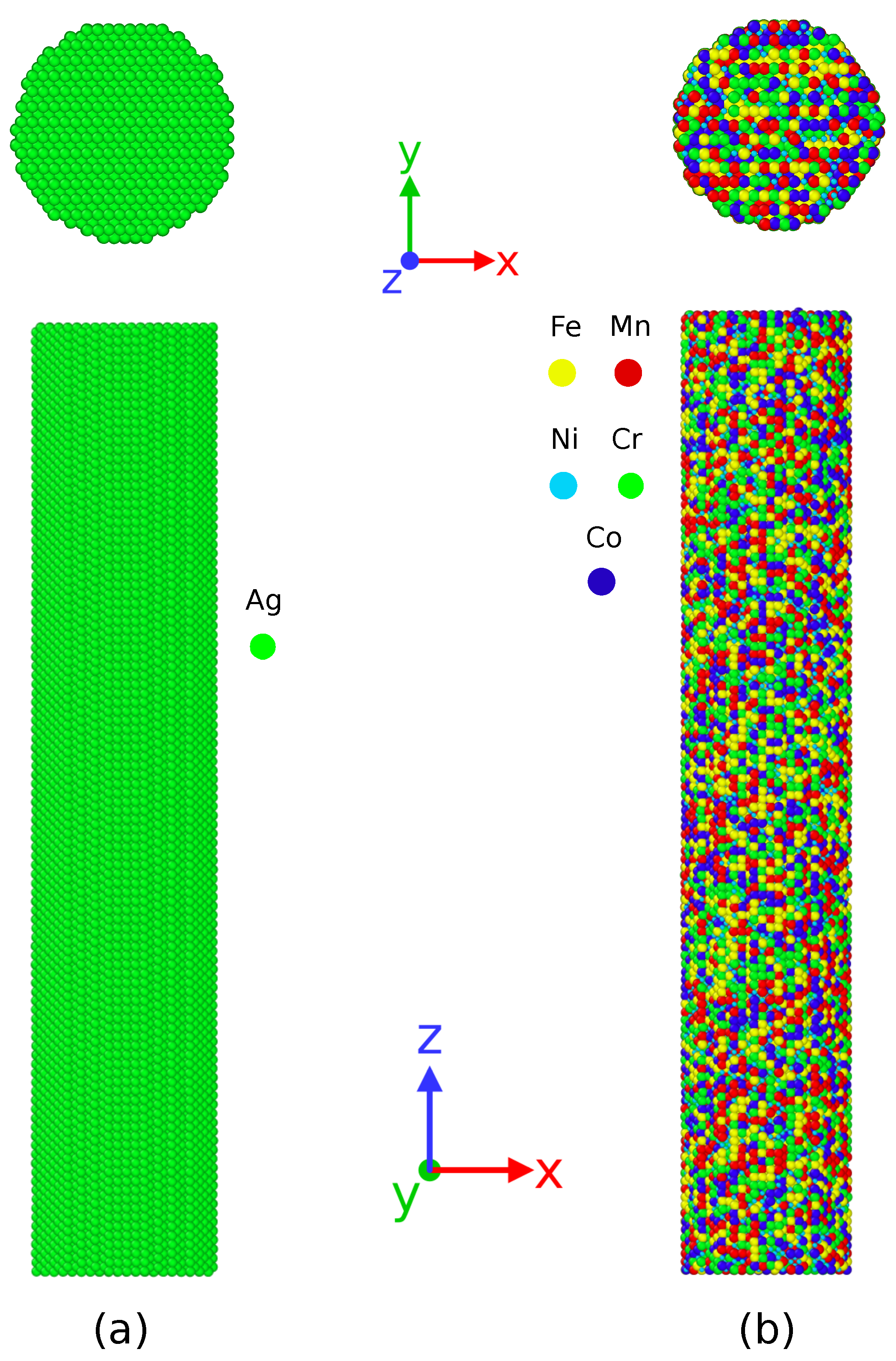
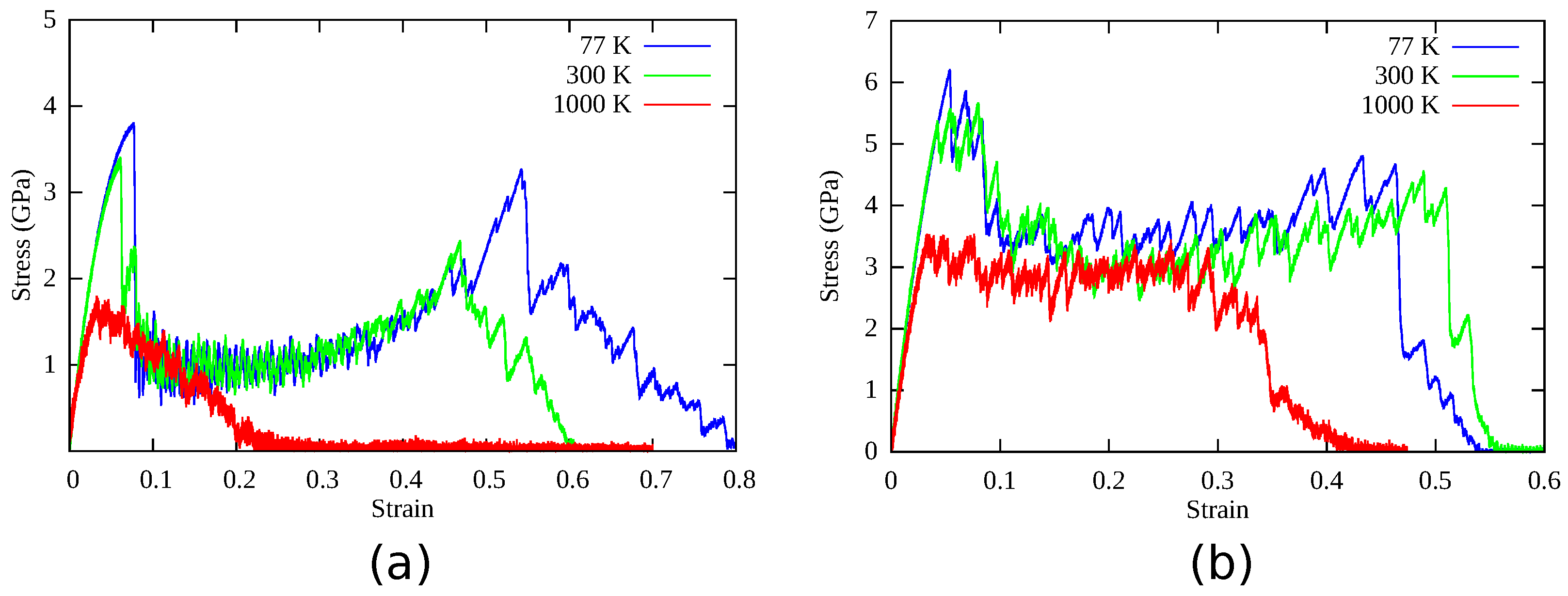
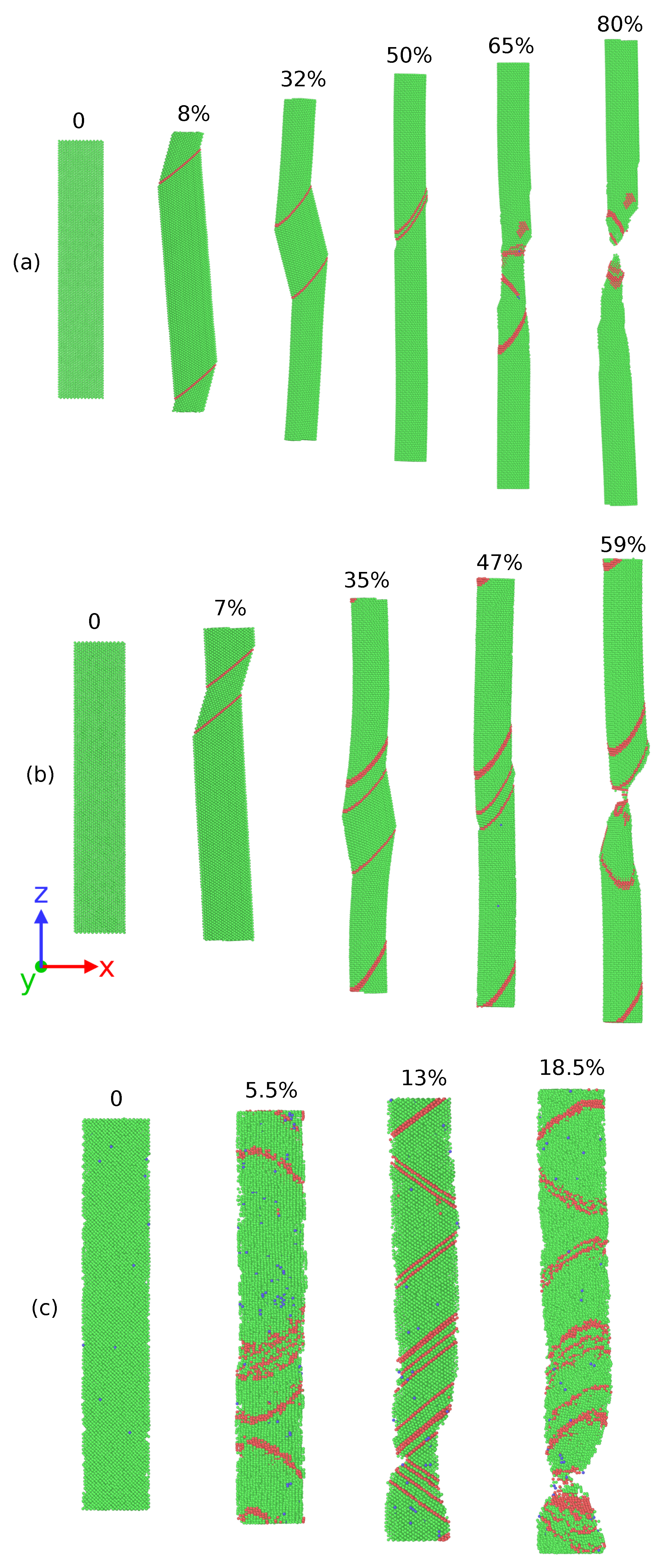
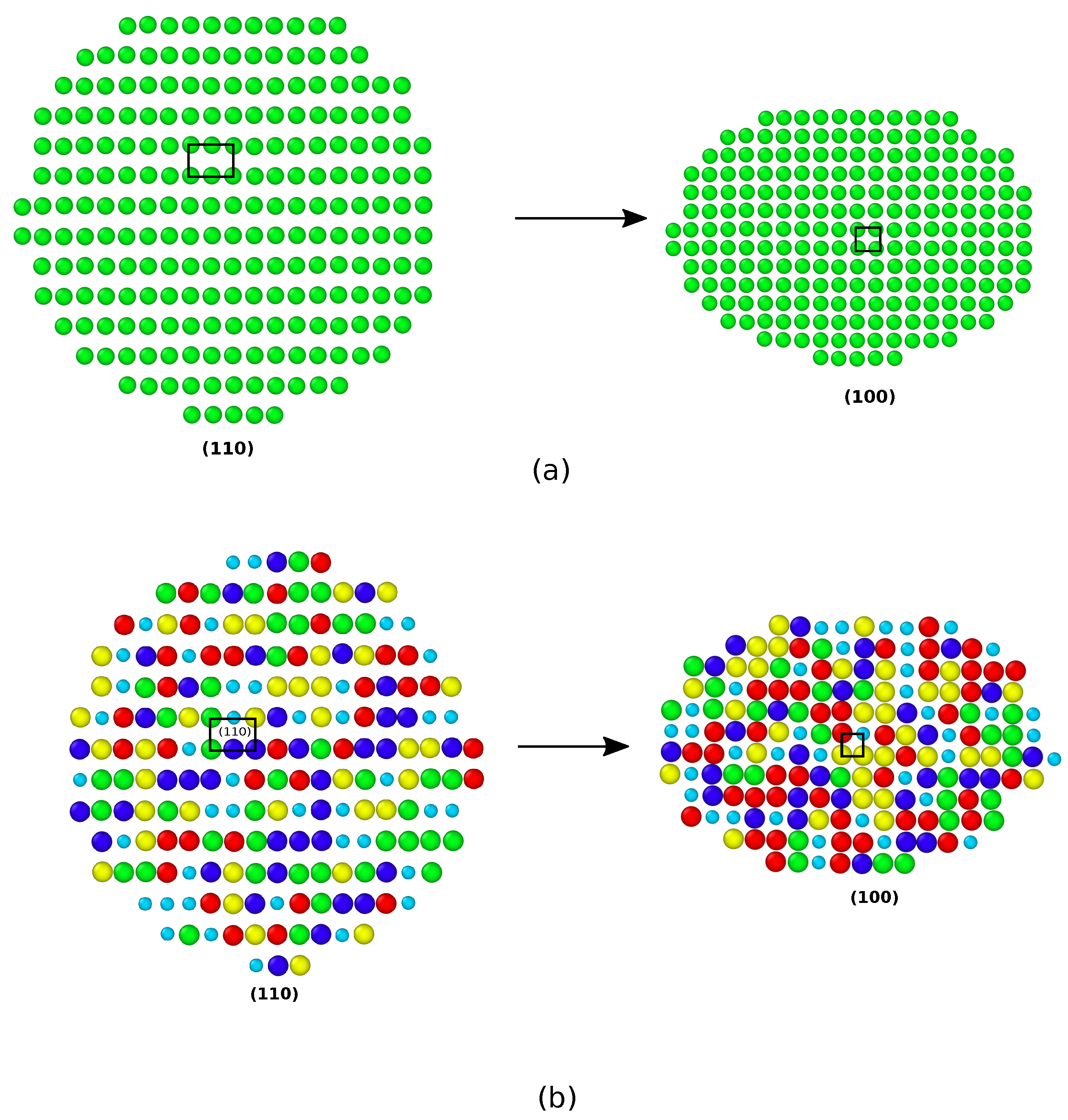

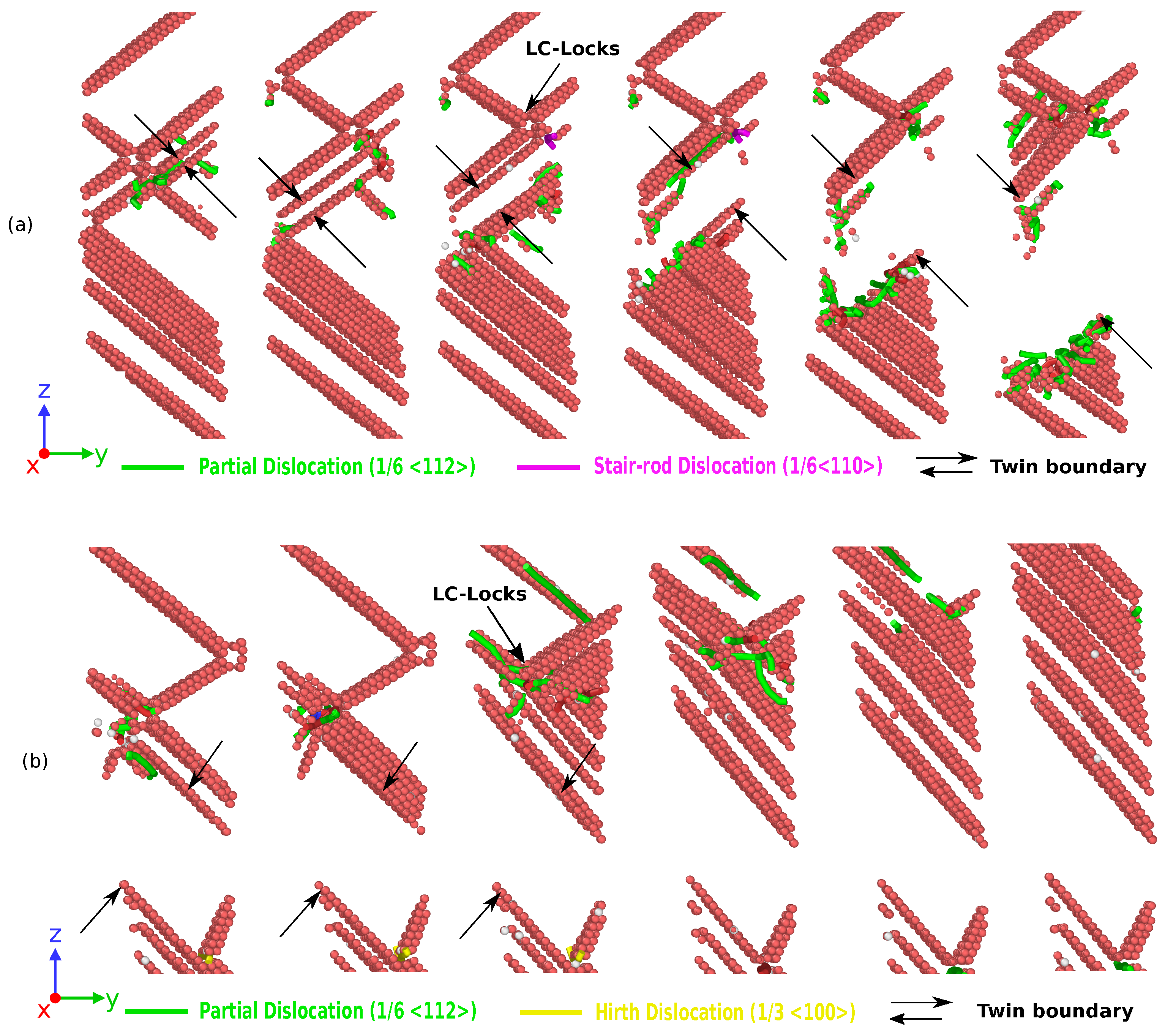
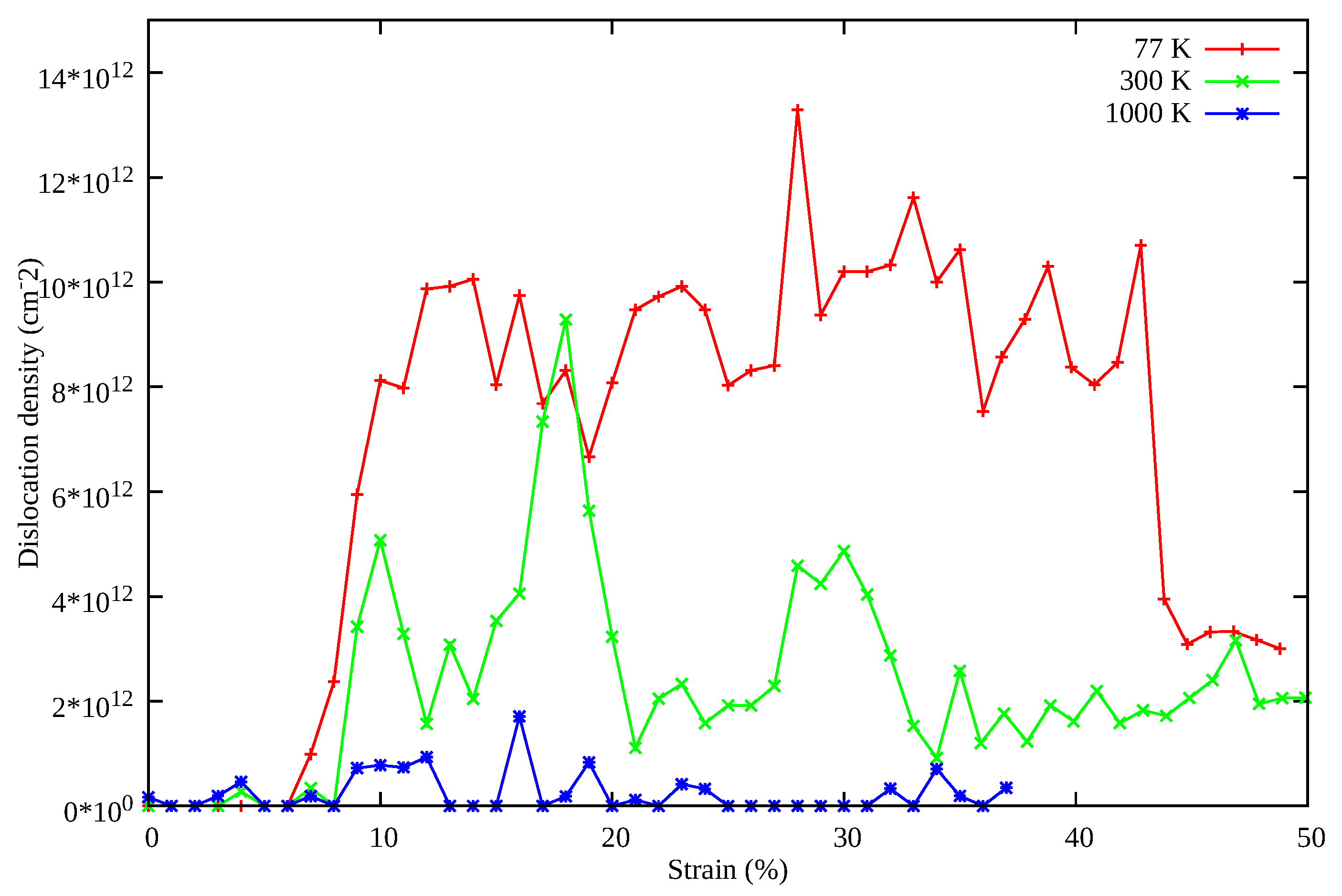
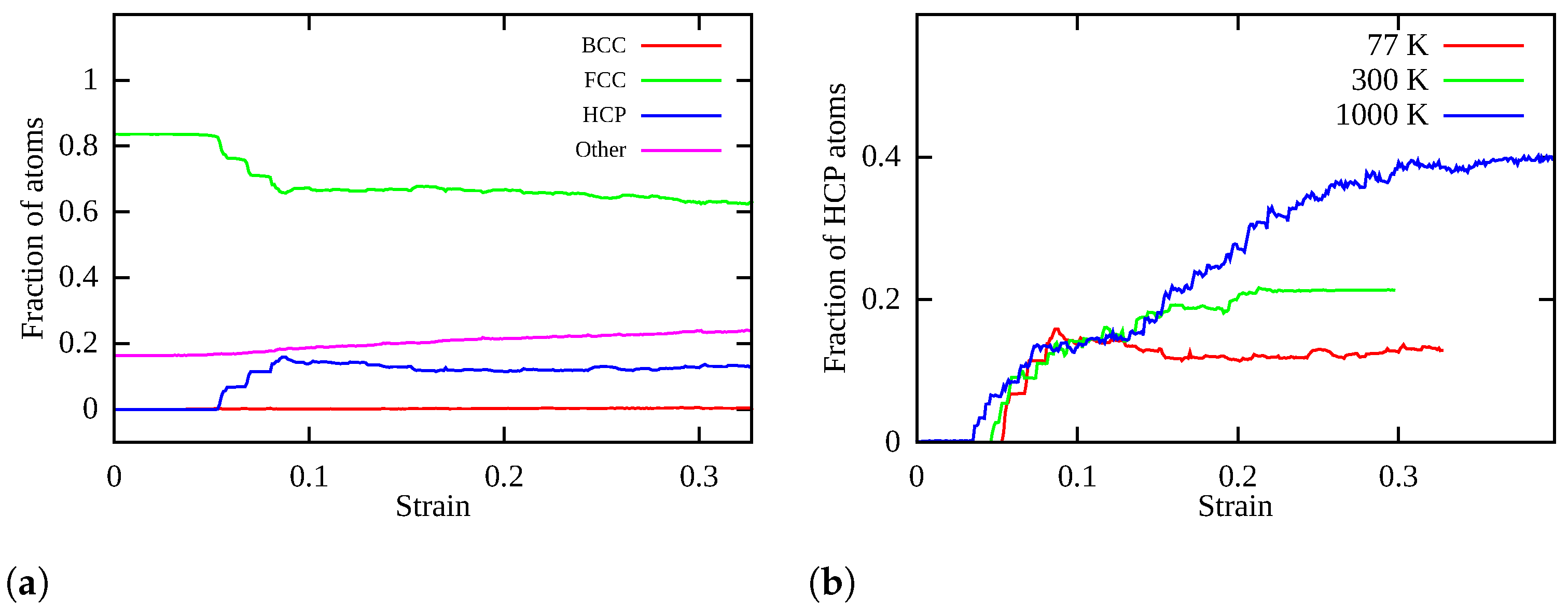

| Nanowire | No. of Atoms | Diameter (nm) | Length (nm) | Orientation |
|---|---|---|---|---|
| Ag | 47,250 | 5 | 30 | X: , Y: [001], Z: [110] |
| HEA | 55,216 | 5 | 35 | X: , Y: [001], Z: [110] |
Publisher’s Note: MDPI stays neutral with regard to jurisdictional claims in published maps and institutional affiliations. |
© 2021 by the authors. Licensee MDPI, Basel, Switzerland. This article is an open access article distributed under the terms and conditions of the Creative Commons Attribution (CC BY) license (https://creativecommons.org/licenses/by/4.0/).
Share and Cite
Tripathi, P.K.; Chiu, Y.-C.; Bhowmick, S.; Lo, Y.-C. Temperature-Dependent Superplasticity and Strengthening in CoNiCrFeMn High Entropy Alloy Nanowires Using Atomistic Simulations. Nanomaterials 2021, 11, 2111. https://doi.org/10.3390/nano11082111
Tripathi PK, Chiu Y-C, Bhowmick S, Lo Y-C. Temperature-Dependent Superplasticity and Strengthening in CoNiCrFeMn High Entropy Alloy Nanowires Using Atomistic Simulations. Nanomaterials. 2021; 11(8):2111. https://doi.org/10.3390/nano11082111
Chicago/Turabian StyleTripathi, Pawan Kumar, Yu-Chen Chiu, Somnath Bhowmick, and Yu-Chieh Lo. 2021. "Temperature-Dependent Superplasticity and Strengthening in CoNiCrFeMn High Entropy Alloy Nanowires Using Atomistic Simulations" Nanomaterials 11, no. 8: 2111. https://doi.org/10.3390/nano11082111
APA StyleTripathi, P. K., Chiu, Y.-C., Bhowmick, S., & Lo, Y.-C. (2021). Temperature-Dependent Superplasticity and Strengthening in CoNiCrFeMn High Entropy Alloy Nanowires Using Atomistic Simulations. Nanomaterials, 11(8), 2111. https://doi.org/10.3390/nano11082111






